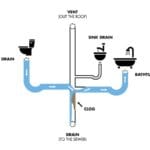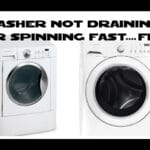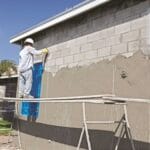Is your Whirlpool washer not spinning and making loud noise? You’re not alone.
Many people face this frustrating issue with their washers. A malfunctioning washer can disrupt your daily routine. Clothes pile up, and the noise can be unbearable. It’s essential to understand the common causes of this problem. Identifying the issue early can save time and prevent further damage.
This guide will help you troubleshoot and fix your Whirlpool washer. From unbalanced loads to mechanical failures, we’ll cover the main reasons behind the noise and spinning problems. By the end, you’ll have a clearer picture and possible solutions to get your washer back to normal. Let’s dive in and tackle these common washer issues together.
Common Causes
If your Whirlpool washer is not spinning and making a loud noise, it can be quite frustrating. Understanding the common causes can help you troubleshoot the issue more effectively. Here, we will discuss some of the most common reasons for this problem.
Unbalanced Load
An unbalanced load can cause your Whirlpool washer to shake and make loud noises. This happens when the clothes inside are not evenly distributed. To avoid this, make sure to:
- Distribute clothes evenly in the drum.
- Avoid overloading the washer.
- Mix large and small items.
Worn Out Bearings
Bearings help the drum spin smoothly. Over time, they can wear out and cause noise. Signs of worn out bearings include:
- Grinding or rumbling sounds.
- Water leaks from the drum.
- Drum does not spin properly.
If you notice these signs, it might be time to replace the bearings.
Clogged Drain Pump
A clogged drain pump can prevent your washer from spinning. Debris like lint, coins, or small items can block the pump. To check for clogs:
- Turn off the washer and unplug it.
- Locate the drain pump filter.
- Remove any debris from the filter.
Regularly cleaning the drain pump filter can prevent this issue.

Credit: www.sloanappliance.com
Initial Troubleshooting
When your Whirlpool washer is not spinning and making a loud noise, it can be frustrating. Before calling a repair service, try some initial troubleshooting. These steps can often solve the issue quickly and save you money.
Check Load Distribution
One of the most common reasons for a washer not spinning is an unbalanced load. Make sure the clothes are evenly distributed in the drum. An unbalanced load can cause the washer to stop spinning and make loud noises.
- Open the washer door and redistribute the load.
- Remove some items if the drum is too full.
- Run a spin cycle with a balanced load.
Inspect For Obstructions
Sometimes, objects can get stuck in the washer drum or filter, causing noise and preventing spinning. Check for any obstructions in the drum and around the agitator.
- Turn off and unplug the washer.
- Look inside the drum and remove any visible objects.
- Check the filter for debris and clean it if needed.
Following these steps can often resolve the issue. If the washer still does not spin, further inspection may be needed.
Fixing Unbalanced Load
Is your Whirlpool washer not spinning and making a loud noise? An unbalanced load might be the cause. Fixing this issue is easy and can save you a lot of trouble. Let’s explore how to fix an unbalanced load.
Redistribute Clothes
When the washer’s drum is unbalanced, it may not spin properly. This can also cause loud noises. The first step is to redistribute the clothes inside the drum.
- Open the washer door.
- Check if the clothes are bunched on one side.
- Spread the clothes out evenly in the drum.
- Close the door and restart the cycle.
This should help balance the load and reduce noise.
Use Smaller Loads
An overloaded washer can become unbalanced. This can cause it to not spin properly and make loud noises. To prevent this, use smaller loads.
- Sort your laundry into smaller piles.
- Load the washer with fewer clothes.
- Ensure the load is balanced before starting the cycle.
Smaller loads help the washer spin correctly and quietly.
| Problem | Solution |
|---|---|
| Clothes bunched on one side | Redistribute clothes evenly |
| Washer overloaded | Use smaller loads |
By following these simple steps, your Whirlpool washer should spin properly and make less noise.
Replacing Bearings
A Whirlpool washer not spinning and making loud noise can be frustrating. The problem often lies in worn-out bearings. Replacing these bearings can restore your washer’s functionality and quiet operation. This section will guide you through identifying bearing issues and the steps to replace them.
Identify Bearing Issues
Before replacing bearings, confirm they are the problem. Look for these signs:
- Loud noises during the spin cycle.
- Excessive vibration or movement.
- Water leakage from the washer.
If you notice these issues, your washer’s bearings may need replacement.
Steps To Replace Bearings
Replacing bearings requires some tools and patience. Follow these steps:
- Unplug the washer: Safety first. Always disconnect the power.
- Remove the top panel: Unscrew the top panel to access the inner parts.
- Detach the front panel: Remove screws holding the front panel in place.
- Access the drum: Locate the drum and the bearing housing.
- Remove the old bearings: Use a bearing puller to extract the worn bearings.
- Install new bearings: Press the new bearings into the housing.
- Reassemble the washer: Put all panels and screws back in place.
- Test the washer: Plug it in and run a cycle to ensure proper operation.
Replacing bearings can be challenging, but it restores your washer’s performance. If unsure, consider hiring a professional.
Cleaning Drain Pump
Is your Whirlpool washer making a loud noise and not spinning? It might be time to clean the drain pump. Over time, debris can clog the drain pump. This can cause loud noises and prevent the washer from spinning. Cleaning the drain pump can fix these issues. It is a simple process that you can do at home.
Locate Drain Pump
First, you need to find the drain pump. It is usually at the bottom of the washer. You may need to remove a panel to access it. Refer to your washer’s manual for specific instructions.
Remove And Clean Pump
Once you have located the drain pump, disconnect it. Check for any visible debris or blockages. Use a cloth to wipe away any dirt or lint. A small brush can help with stubborn debris. Rinse the pump under warm water to remove any remaining dirt.
After cleaning, reattach the pump. Make sure everything is secure. Run a short wash cycle to test if the noise is gone. Your washer should now spin properly.

Credit: www.youtube.com
Examining The Drive Belt
If your Whirlpool washer is not spinning and making loud noises, the drive belt might be the problem. The drive belt connects the motor to the drum. When the belt wears out, it can slip or break, causing noise and stopping the spin cycle. Checking the drive belt is easy and can save you from costly repairs.
Signs Of A Worn Belt
There are several signs that indicate a worn drive belt:
- Unusual Noises: A squealing or grinding noise during the spin cycle.
- Drum Not Spinning: The drum may not spin at all or spins slowly.
- Visible Damage: Cracks, fraying, or a shiny glazed look on the belt.
How To Replace The Belt
Replacing the drive belt on a Whirlpool washer is straightforward. Follow these steps:
- Unplug the Washer: Ensure safety by disconnecting the power supply.
- Access the Belt: Remove the back panel of the washer to locate the belt.
- Remove the Old Belt: Slide the old belt off the pulleys.
- Install the New Belt: Place the new belt around the motor pulley and then around the drum pulley.
- Check Alignment: Ensure the belt is aligned correctly on the pulleys.
- Reassemble the Washer: Replace the back panel and plug in the washer.
Your washer should now operate quietly and spin efficiently.
Checking Motor Coupling
Is your Whirlpool washer making a loud noise and not spinning? The problem might be the motor coupling. The motor coupling connects the washer’s motor to the transmission. If it is damaged, your washer will not spin properly and might produce loud noises. Here’s how to identify and replace a faulty motor coupling.
Symptoms Of A Faulty Coupling
- Loud noises: Your washer may make banging or grinding sounds.
- No spinning: The washer drum does not spin during the cycle.
- Clothes are wet: Your laundry remains wet after the cycle ends.
- No agitation: The washer fails to agitate during the wash cycle.
Replacement Process
Replacing the motor coupling is a straightforward process. Follow these steps to get your washer running smoothly again.
- Unplug the washer: Safety first. Ensure the washer is disconnected from the power source.
- Access the motor coupling: Remove the washer’s back panel or bottom panel to locate the motor coupling.
- Remove the old coupling: Detach the motor and transmission from the coupling. This may require a screwdriver or socket wrench.
- Install the new coupling: Position the new coupling between the motor and transmission. Ensure it is secure.
- Reassemble the washer: Reattach the back or bottom panel. Plug the washer back in.
- Test the washer: Run a test cycle to ensure the washer spins and operates without noise.
By checking and replacing the motor coupling, you can resolve many common issues with your Whirlpool washer.

Credit: www.sloanappliance.com
When To Call A Professional
A noisy Whirlpool washer that doesn’t spin can be frustrating. Sometimes, fixing it yourself isn’t an option. Knowing when to call a professional can save time and prevent further damage. Let’s explore how to identify complex issues and find a reliable technician.
Identifying Complex Issues
Some washer problems are easy to spot. A loose belt or clogged drain may be fixable. But, some issues are harder to identify. If your washer makes loud noises during the spin cycle, it could signal a serious problem. Bearings, motor coupling, or suspension springs might be the cause. These parts often need expert handling.
Another sign is if your washer stops mid-cycle. This could be due to electrical issues. It may need a professional’s touch. Dealing with complex issues without the right tools can be risky. It’s often best to call an expert.
Finding A Reliable Technician
Finding the right technician is crucial. Start by checking reviews online. Look for technicians with positive feedback. Ask friends and family for recommendations. They might know a reliable professional.
Make sure the technician is certified. Certification ensures they have the right skills. Also, check if they offer a warranty on their work. A good technician will stand by their service. Clear communication is important too. They should explain the problem and solution clearly. This helps build trust.
Frequently Asked Questions
Why Is My Whirlpool Washer Making A Loud Noise?
A Whirlpool washer may make loud noise due to a worn-out drum bearing, loose parts, or an unbalanced load.
How Do I Fix My Whirlpool Washer That Won’t Spin?
Check the lid switch, drive belt, and motor coupling. Replace any damaged parts. Balance the load properly.
Can An Unbalanced Load Cause My Washer To Be Loud?
Yes, an unbalanced load can cause loud noise. Distribute clothes evenly to avoid this issue.
What Parts Should I Check If My Washer Is Noisy?
Check the drum bearing, motor coupling, and drive belt. These parts often cause noise if worn out.
How Can I Prevent My Washer From Making Noise?
Regularly check and tighten parts. Avoid overloading. Balance loads evenly to prevent noise.
Conclusion
Resolving a noisy Whirlpool washer is crucial. Start with checking the load balance. Then, inspect the drive belt and motor coupling. Look for obstructions in the drum. Regular maintenance helps prevent issues. Consult a professional if problems persist. Ignoring noise can lead to bigger repairs.
Keep your washer in top shape for smooth operation. Remember, a well-functioning washer saves time and hassle. Happy washing!





